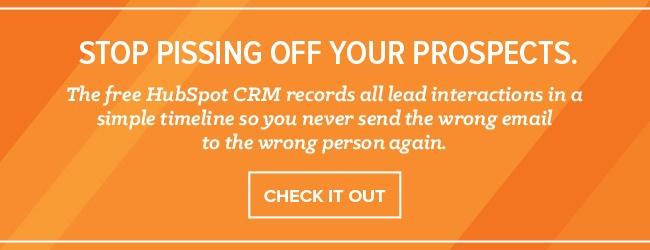Imagine this: You’ve just received a new email, adding yet another to the 200 messages already crowding your inbox. But once you start reading, you realize this email feels a little different from the rest. The formatting on your name is a little off and some guy you’ve never heard of before is writing to you as if you’re old pals.
Congratulations. You’ve been targeted by automated email outreach -- and not the good kind.
Email prospecting is clearly a valuable strategy for sales reps. Unfortunately, it’s often poorly managed and poorly customized. Done right, however, it opens doors that would never otherwise be cracked. Here are 10 strategies to optimize your sales emails.
10 Easy Improvements to Make to Your Sales Emails
1) Eliminate “I know how you’re feeling” statements.
We’ve become so accustomed to beginning our emails with, “I know how you’re feeling” or “I know what you’re thinking.” The problem is, we usually don’t. And when we assume we’re speaking to a prospect’s pain points, we run the risk of missing the mark by a mile.
Try this instead: “This [piece of content] was interesting to a colleague of mine in your field. Wanted to share it in case it resonates with you, too.”
2) Prioritize clarity over cleverness.
“A prospect walks into an email …”
What do you think? Should I continue down this road? Nine out of 10 people will probably say no.
Humor is an excellent addition to any relationship. It just shouldn’t be the main point of your outreach emails. Start out by showing buyers you’re a trusted professional who’s there to support their actual business needs.
Be diligent about the purpose of each line in your email. Try reading through an email and asking yourself, “What’s the main point I’m making in this sentence?” If there’s no compelling reason for the sentence to be there, or it’s for laughs alone, cut it. If there are multiple sentences making the same point, combine them. This will trim extra words and keep your sales emails short and to the point.
3) Include something a prospect can’t find on Google.
Think of the most popular person at a party. They usually have something that draws people to them, even if it’s not initially apparent. More often than not they’re appealing because they have something compelling to offer. Something that no one else has.
The same can be said of effective outreach emails. Emails that can offer a bit of value beyond “Want to talk to a stranger on the phone?” -- whether it’s a statistic, tool, or resource -- are the ones that will engage a prospect more effectively.
So take the opportunity to demonstrate something. Link to a demo. Offer something (resources, content, a survey) besides a strong-arm tactic to start a conversation. Something, of course, that can’t simply be Googled.
4) Acknowledge that you’re strangers.
In email outreach, we often work under the assumption that people will be receptive to traditional relationship building techniques. So if we’re friendly and approachable, we expect the same courtesy. And if a prospect doesn’t respond or if they’re curt, we get frustrated.
But if you stop to think -- do they really have a reason to trust a stranger yet? Not really.
When introducing yourself, be clear that you aren’t intimately familiar with them and avoid any of the “shady” sales behaviors that destroy buyers’ trust.
5) Get peer feedback on your emails.
It’s amazing how infrequently sales teams take advantage of peer-to-peer editing. Emails are usually written and edited by a single person and maybe their manager. But peer networks are pure feedback gold.
Send your email drafts to your team and ask for opinions. What sounds off? What sounds weird? What sounds a little crazy or creepy?
As people who get emails from SDRs or sales reps from other companies, your peers most definitely have an opinion on what resonates and what doesn’t. Gather and use the additional perspective.
6) Test your emails by sending them to yourself.
Sending an email draft to a team to get feedback is incredible. But sometimes you don’t have the luxury of doing this. So at the very least, send the email to yourself. Format as you would for your regular outreach, put your email in the “To” line, and hit “Send.”
Having an email display as it would in your prospect’s inbox will give you a better sense of what they’ll see. Step in their shoes as you click it open and scan it. Nine times out of 10, there will be a few things you want to change or improve.
We’re our own worst critics. Use it to your advantage in this case.
7) Add something of value to your signature.
Your sign-off is a part of your email, but it’s often left a blank canvas. Add a video to your signature. Media. Anything that could tell them easily what you do and how you do it.
One word of wisdom -- be selective about what you add to the signature. Some signatures get so stuffed with information they could practically be considered biographies. Start by including your name, title, and company. Then be judicious in what you add on so you don’t overdo it.
8) Proofread.
I almost feel embarrassed to add this one, but it must be included. Why? Because outreach emails are often rife with typos. Worse, some of these typos show up in the prospect’s name and/or company name.
So just take a minute to look at your emails again. If you need help spotting grammatical errors, pass it by another set of eyes. Double check prospect names for capitalization, the company name for capitalization, spacing, and CamelCase.
Grammarly is a great tool for helping to double-check, though there’s no substitute for a careful detailed-oriented eye.
9) Read your draft out loud.
You can expect 90% of your readers to begin an email by skimming through it.
Overly complicated sentences or verbose introductions become obstacles for readers. Don’t exhaust your prospects’ mental patience before they have a chance to get to the point.
One of the most effective ways to stress test a piece of writing is to test it as an oral piece. Read your email out loud. Notice where you stumble. Take note of sentences that go on forever. Edit accordingly.
10) Draft wildly different emails.
We’re creatures of habit. So when we sit down to write a new draft, we fall prey to producing emails that use the same syntax and the same pacing. Or we try to Frankenstein something together using old emails, copying and pasting until we have a beginning, middle, and end, regardless of whether that beginning, middle, and end flow well together.
I challenge you to write one email as you normally would. Then write a wildly different email that uses an entirely different approach. Not only will this help you create a good sample pool of templates to test, it’ll give your brain’s creative muscles a much-needed workout.
Drafting completely different emails will also get you out of the habit of trying to write “one-size-fits-all” emails.
When we think about building relationships, we don’t usually think about how we can net 1,000 best friends using one, scripted conversation. So why do we try to land 200 prospects by sending them the same email?
Instead of trying to craft the perfect subject line or template that will attract every person on the planet, think in terms of segmentation. Ask, “What might work with this particular segment?” Narrowing your focus only broadens your ability to connect authentically with a group of people.
The sales reps that succeed are the ones who are willing to adapt and learn from their experiences. Use these tips to improve your current email outreach. Be ready to test, assess, and iterate. And keep me posted!





